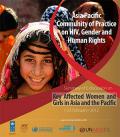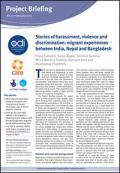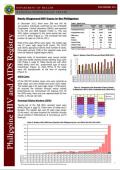What's New
Displaying results 3681 - 3690 of 4914

Resource | Publications,
From 1-23 February 2012, the Asia Pacific Community of Practice on HIV, Gender and Human Rights (HIV-APCoP) held an e-discussion on Key Affected Women and Girls in Asia and the Pacific with the primary objective of stimulating dialogue to ensure proper policy attention is paid to key affected women and girls in the context of HIV.

Resource | Publications,
Tuvalu formerly known as the Ellice Islands is located in the South Pacific, just to the north of the Fiji Islands. It is the smallest independent country in the South Pacific, comprising of nine low lying coral atolls with a population of 9561.
Tuvalu reported its first case of HIV in 1995. Since then there has been 11 confirmed cases of which four have died (all were males and the deaths occurred in the years 2004, 2007, 2008, 2011).

Resource | Fact Sheets,
In January 2012, there were 212 new HIV Ab seropositive individuals confirmed by the STD/AIDS Cooperative Central Laboratory (SACCL) and reported to the HIV and AIDS Registry (Table 1). This was 39% higher compared to the same period last year (n=152 in 2011) [Figure 1].

Resource | Publications,
This report provides biological and behavioral information on HIV among mine workers in Balochistan from a survey conducted in September 2011 in the mining areas of Muslim Bagh, Sorange and Mach. The purpose of the study was to collect, analyze and disseminate accurate information on the prevalence of key risk behaviors and of HIV among mine workers to deliver sustained and effective HIV prevention, treatment care and support services.

Resource | Publications,
Gender-based violence (GBV) is under-reported and under-researched in Vietnam (Gardsbane et al. 2010). Several small-scale studies revealed that the prevalence of GBV in Vietnam ranges widely from 16 to 37 percent for physical violence, and 19 to 55 percent for emotional violence, while sexual violence and sexual harassment are rarely reported (Jonzon et al. 2007; Nguyen 2006; Vu et al. 1999). A 2006 national survey with 9,300 households reported that in the preceding 12 months, 21.2 percent of families had reported at least one of the three forms of violence (physical, verbal, coerced sex); husbands were the most frequent perpetrators (Huong 2008). In everyday life, verbal abuse, slapping, and coerced or forced sex are often not considered violence in Vietnam (United Nations Population Fund [UNFPA] 2007).

Resource | Fact Sheets,
The United Nations General Assembly High Level Meeting (HLM) on HIV/AIDS was held in New York in 2011. As an outcome of the HLM, the 2011 Political Declaration on HIV/AIDS, UN Resolution 65/277 (hereafter referred to as the 2011 Declaration) was adopted. This issue of InFocus zooms in on what the Declaration means for the lives of women and girls in Asia and the Pacific in the context of the challenges they face and policy and programme responses needed to overcome these. This fact sheet is a tool to hold governments accountable to their commitments and targets for women and girls and to use for calling for a more women-centered response to the HIV and AIDS epidemic.

Resource | Publications,
This Project Briefing explores the experiences of these people as they migrate, drawing on findings from a baseline study on their vulnerabilities, particularly to HIV and AIDS, as they move between their communities of origin in Nepal and Bangladesh to India. Although the baseline used quantitative and qualitative approaches, stories of harassment and violence emerge mostly from the qualitative elements.

Resource | Publications,
The epidemiology of HIV infection in the Philippines has shifted dramatically in the last five years. A combination of increased risk behavior among young Filipinos, low levels of knowledge regarding HIV transmission and prevention, and underfunded HIV prevention and treatment programs may have led to a rapid rise in HIV incidence and prevalence. Much of the increase in HIV transmission appears to have occurred among young men who have sex with men (MSM) and persons who use intravenous drugs (PWID) in major urban centers.

Resource | Fact Sheets,
In December 2011, there were 268 new HIV Ab seropositive individuals confirmed by the STD/AIDS Cooperative Central Laboratory (SACCL) and reported to the HIV and AIDS Registry (Table 1). This was 54% higher compared to the same period last year (n=174 in 2010) [Figure 1]. This increased the total number of cases to 2,349 for 2011.

Resource | Publications,
This document is an in-depth analysis of the data on the MSM population generated by the 2009 Integrated HIV Behavioral and Serologic Surveillance System (IHBSS). IHBSS is a biennial study of the Department of Health to collect, analyze, and interpret data on HIV and AIDS in 20 selected sites across the country. Blood samples were taken from the respondents, and the serologic result for each of them was then matched with the behavioral survey they have completed using an identification number assigned to them.





